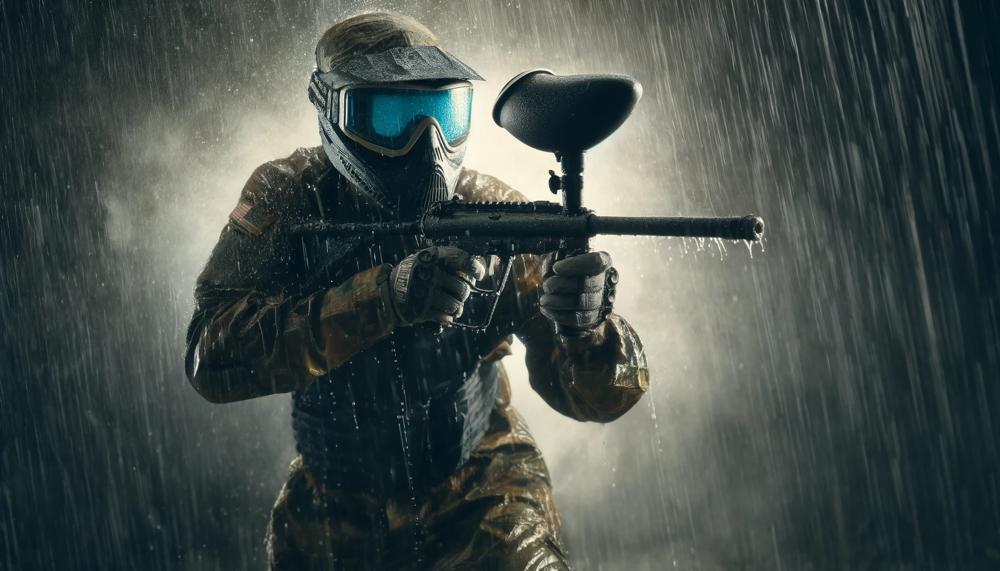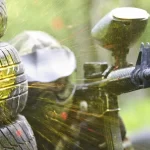Did you know that despite a drop in visibility and added slipperiness, over 30% of avid paintball enthusiasts relish the opportunity to play during rainy conditions? This surprising affinity for rain-soaked matches underscores a unique dimension of the sport, turning typical gameplay on its head and introducing a thrilling blend of challenge and fun.
Playing paintball in the rain doesn’t just test your aim and agility; it transforms the battlefield into a slick, unpredictable arena, demanding new strategies and attitudes. Whether you’re a seasoned player or a curious newcomer, mastering a rainy day match can elevate your paintball experience to exhilarating new heights.
So, how do you play paintball in the rain and have fun?
Playing paintball in the rain can be a fun and exciting experience if you’re prepared. Here are some tips to help you enjoy your game:
- Protect Your Paintballs From The Rain: Keep your paintballs as dry as possible. Moisture can cause them to deform and reduce accuracy. Make sure that the bags are tied up or folded over so no moisture in the air gets inside.
- Keep Your Gear Covered: Not all fields have overhead cover or only have a limited amount of space under a canopy. You can use an empty paintball box or bag to cover your gear. If you brought any garbage bags, just put your gear inside of them.
- Don’t Use Speedfeeds: Speedfeeds are designed to quickly fill your hopper with paint without having to open up your hopper lids, but they do not protect the paintballs and motor inside from the elements and dirt.
- Wear Comfortable and Water-Resistant Clothing: Comfortable and water-resistant wear make a huge difference in whether you will be able to play several games on a rainy day. Rain ponchos with hoods are great. If you do not own a rain poncho, try cutting a hole in the middle of a large trash can liner and wear it.
- Choose the Right Footwear: Sports cleats with traction will keep you from slipping on wet turf, especially when running to dodge behind a field bunker.
- Maintain Your Gun: If the inside of your gun becomes wet, take apart your gun and dry it out with a cloth and use a squeegee for the barrel.
- Use a Visor and Anti-Fog Spray: If you are using your own paintball battle mask, it should have a visor. This will keep rain somewhat off your lenses. Carry some antifog spray and a soft, microfiber cloth for when your mask becomes fogged when playing in the rain.
Dive into the details below as we explore how to not just endure but enjoy paintball in the rain, making every splash and slide part of the unforgettable adventure.
Table of Contents
Preparation for Playing Paintball in the Rain
Playing paintball in the rain requires meticulous preparation to ensure both enjoyment and safety. Here’s a detailed breakdown of the essential gear and tips for optimizing your wet weather paintball experience:
| Item | Description | Purpose |
| Waterproof Clothing | Water-resistant jacket and trousers | Keeps you dry and comfortable |
| Paintball Mask with Anti-Fog Lens | Thermal lenses | Ensures clear vision and safety |
| Waterproof Gloves | Water-resistant material | Improves grip and hand protection |
| Marker | Clean and maintained, suitable for wet conditions | Reliable performance in the rain |
| Waterproof Hopper Cover | Protects paintballs from moisture | Prevents paintball swelling and jams |
| Barrel Cover | For safety when not in active play | Essential in slippery conditions |
| Anti-Fog Spray | Apply to mask lenses | Reduces lens fogging |
| Silica Gel Packs | Place in gear bag | Absorbs excess moisture |
| Towel | Microfiber material | For wiping down equipment |

Tips for Playing Paintball in the Rain
Playing paintball in the rain brings unique challenges and demands specific precautions to ensure safety and enjoyment. Here are some essential safety measures to consider:
- Maintain Dry Gear
- Paintball Gun: Always keep the interior of your paintball gun dry. Use a squeegee to clear moisture and store the gun with the lid closed when not in use.
- Paintballs: Store paintballs in a waterproof container to prevent them from swelling and losing accuracy due to moisture.
- Visibility
- Mask Care: Utilize a paintball mask with a visor to shield your vision from rain. Apply anti-fog spray to the inner side of the mask lens and have a soft cloth handy to wipe away any fog or water droplets that form.
- Appropriate Clothing
- Layers: Dress in layers to reduce the sting of paintballs, which can feel more intense in cooler, wet conditions. Waterproof outer layers are ideal to keep you dry and warm.
- Field Conditions
- Safety Checks: Prioritize safety by assessing the field’s condition. Avoid areas that may become slippery or muddy, increasing the risk of falls and injuries.
| Safety Feature | Precautions | Reasons |
| Gun Maintenance | Keep dry, use squeegee | Prevents internal moisture damage and maintains accuracy |
| Mask Care | Use visor, apply anti-fog | Enhances visibility, prevents accidents due to impaired vision |
| Clothing | Wear waterproof layers | Protects from cold and impacts, improves comfort |
| Field Safety | Avoid slippery areas | Reduces risk of falls and related injuries |
Can I Play Paintball in the Snow?
Yes, you can indeed play paintball in the snow, offering a unique and exhilarating gaming experience. However, it requires careful preparation and adaptability to ensure both fun and safety. The chilly environment demands specific adjustments and precautions:
- Clothing: Dress in layers to stay warm and dry, using moisture-wicking fabrics as a base to prevent sweat accumulation.
- Paintballs: Opt for thicker-shelled paintballs that are less prone to breaking in low temperatures.
- Equipment: Regularly check and maintain your paintball gun to prevent malfunctions due to cold weather.
- Movement: Be mindful of slippery surfaces and adjust your tactics to maintain balance and prevent injuries.
The Field Is Yours
To ensure your paintball gear is ready for a rainy game, it’s crucial to adapt your equipment and approach. Here’s a detailed preparation guide:
- Apparel: Choose synthetic materials that repel water rather than absorb it, such as polyester or nylon, to stay dry and maintain mobility. Avoid cotton as it retains moisture and can lead to discomfort.
- Footwear: Opt for waterproof boots with good grip. Slippery conditions underfoot can affect stability, so well-treaded shoes are essential.
- Mask: A low-profile mask with anti-fog features is ideal. Rain can cause masks to fog up more quickly, which reduces visibility and can affect your performance.
- Aiming and Shooting: Rain can alter the trajectory of paintballs. Practice leading your shots more than usual to compensate for the additional weight of waterlogged paintballs and potential wind interference.
- Awareness and Tactics: Rain can mask the sound of movement, giving you a tactical advantage if you remain more alert than your opponents. Use the noise of the rain to move stealthily.
- Using Cover: Position yourself strategically where cover can shield you from direct rainfall. This tactic not only keeps you drier but also makes it harder for opponents to spot you.
- Safety Gear: Ensure all your safety gear, especially masks and goggles, are fitted properly and are clear of water spots to maintain clear vision throughout the game.
- Regular Gear Checks: Rain can affect the functioning of your paintball marker. Regularly check and maintain your equipment to prevent malfunctions due to moisture.
Paintball Tank Hydro Testing
Hydro testing a paintball tank is a critical process designed to ensure the safety and integrity of the tank, which holds the compressed air or CO2 that powers paintball markers. The primary purpose of this testing is to check for any potential leaks, deformities, or weaknesses in the tank’s structure that could pose safety risks during gameplay.
This thorough examination includes filling the tank with a pressurized liquid, often water, to ensure it can handle operational pressures without failure.
The frequency of hydro testing is dictated by industry standards and safety regulations, recommending that these tests be conducted every three to five years. This periodic assessment helps maintain the highest safety standards, allowing players to engage confidently and securely in the sport.
For a more detailed overview, consider the schedule and guidelines in the following table:
| Test Interval | Reason | Outcome |
| Every 3-5 years | To identify any structural weaknesses or damage that may have occurred over time or through use. | Ensures the tank remains safe to use under the pressures required for paintball. |
| After any significant impact or damage | To confirm the integrity of the tank following any incidents that could compromise safety. | Prevents the use of a potentially compromised tank, enhancing player safety. |
| Before first use (if not pre-tested by manufacturer) | To verify the manufacturer’s quality and safety of the tank prior to its operational use. | Assures the user of the tank’s safety and functionality from the outset. |
How to Make a Paintball Team
When forming a successful paintball team, certain key factors should be considered to enhance your team’s performance and cohesion on the field. Below is a detailed breakdown of these factors:
| Team Composition | Recruit a balanced mix of skills and experience. Include sharpshooters, strategists, and quick movers to cover all aspects of gameplay. |
| Clear Objectives | Set specific goals for the team, whether it’s winning local tournaments or simply improving as a group. Clear objectives guide training and strategy. |
| Regular Practice | Organize frequent practice sessions to develop team strategies and communication. Simulate various game scenarios to enhance adaptability. |
| Communication Protocols | Develop effective communication methods, including verbal codes and hand signals, to use during matches for stealth and efficiency. |
| Role Assignment | Assign specific roles based on each member’s strengths and weaknesses. Roles like sniper, rusher, or support must be clear to all members. |
| Equipment Management | Ensure all team members have reliable gear that suits their roles. Regular checks and maintenance are crucial to avoid malfunctions during games. |
| Physical Fitness | Encourage a fitness regime that enhances stamina, agility, and strength. Paintball is physically demanding, and fitness can greatly influence performance. |
| Networking | Engage with the wider paintball community to learn from more experienced teams and find opportunities for friendly matches and tournaments. |
| Sponsorship and Promotion | Seek sponsorships to fund better equipment and tournament fees. Promote your team through social media to increase visibility. |
| Team Spirit and Trust | Foster a supportive environment where team members feel valued and motivated. Trust and camaraderie are essential for a cohesive team. |
Each of these elements plays a crucial role in the formation and success of a paintball team.
How to Play Paintball With Glasses (6 Effective Strategies)
Playing paintball with glasses doesn’t have to be a hassle. Here are six effective strategies that blend comfort, safety, and clear vision, ensuring your paintball experience remains both enjoyable and competitive.
| Select a High-End Mask | Opt for a mask with an anti-fog function and superior breathability. These features help to prevent your glasses from fogging up during intense gameplay, keeping your vision clear. |
| Choose the Right Fit | Ensure the mask has a wide nose bridge to comfortably accommodate your glasses. An ill-fitting mask can lead to discomfort and distraction, undermining your focus and enjoyment. |
| Use Anti-Fogging Solutions | Before stepping onto the field, apply an anti-fogging solution to your glasses. This simple preparation can make a significant difference in maintaining clear vision throughout the game. |
| Secure Your Glasses | Adjust your glasses to fit snugly and consider using a strap or retainer to keep them securely in place while you move. This prevents the glasses from slipping or causing pressure on your face. |
| Opt for Polycarbonate Lenses | Glasses with polycarbonate lenses are recommended for their impact resistance. They offer added protection against flying paintballs and debris, ensuring your eyes are well protected. |
| Consider Alternative Lens Types | Explore options like polarized, photochromic, or transition lenses to enhance visual clarity and adapt to varying light conditions on the paintball field. |
Each of these strategies prioritizes your comfort and safety, letting you focus on the thrill of the game without the inconvenience of glasses-related issues.
Conclusion
As rain pelts the paintball arena, each droplet adds a thrilling dimension to your match, transforming the usual tactics into a lively dance of agility and strategy. Embracing the elements becomes a game-changer, where visibility is reduced and surfaces turn slippery, demanding both mental and physical sharpness. To excel in these conditions, ensure your gear is up to the task: a waterproof jacket, a mask with anti-fog lenses, and a steadfast grip on your marker are indispensable.
Adapt your gameplay to capitalize on the rain’s camouflage effect, using its sound to mask your movements and gain a tactical advantage. Your preparedness—spanning from the strategic use of anti-fog sprays to the maintenance of your equipment—ensures that every splash and slide enriches your experience rather than detracts from it.
As you play, the key is to maintain safety without sacrificing the thrill. The rain shouldn’t dampen your spirits but should invigorate your game, turning every match into an unforgettable adventure. Remember, in paintball, as in life, sometimes it’s the storms that bring out the best in us, turning challenges into opportunities for triumph.






